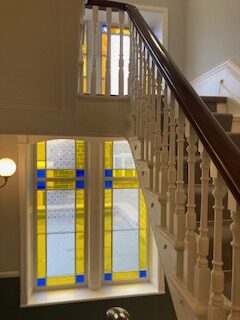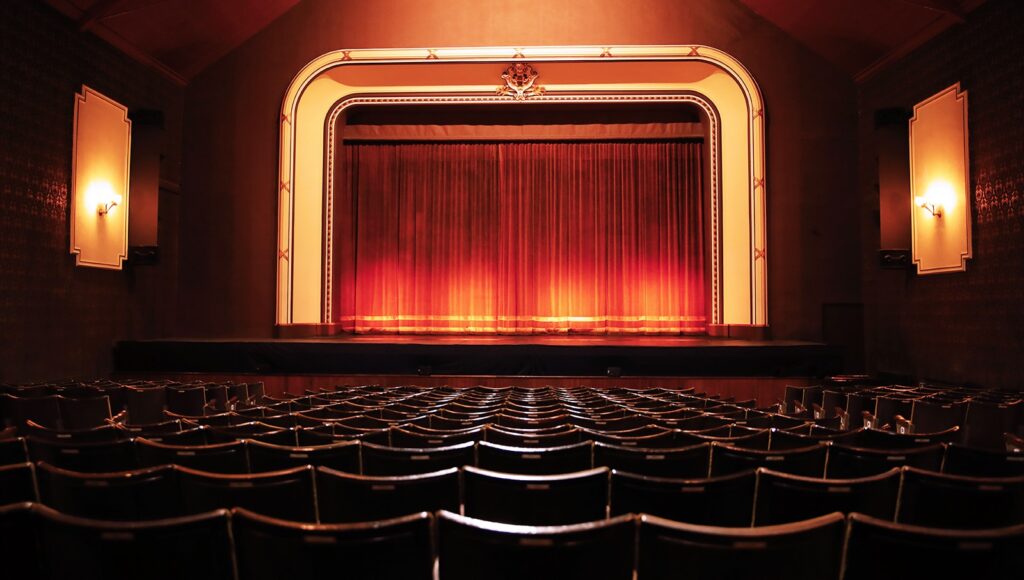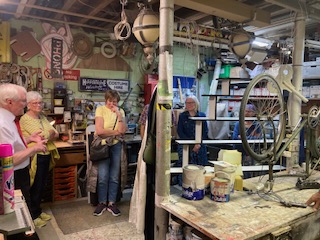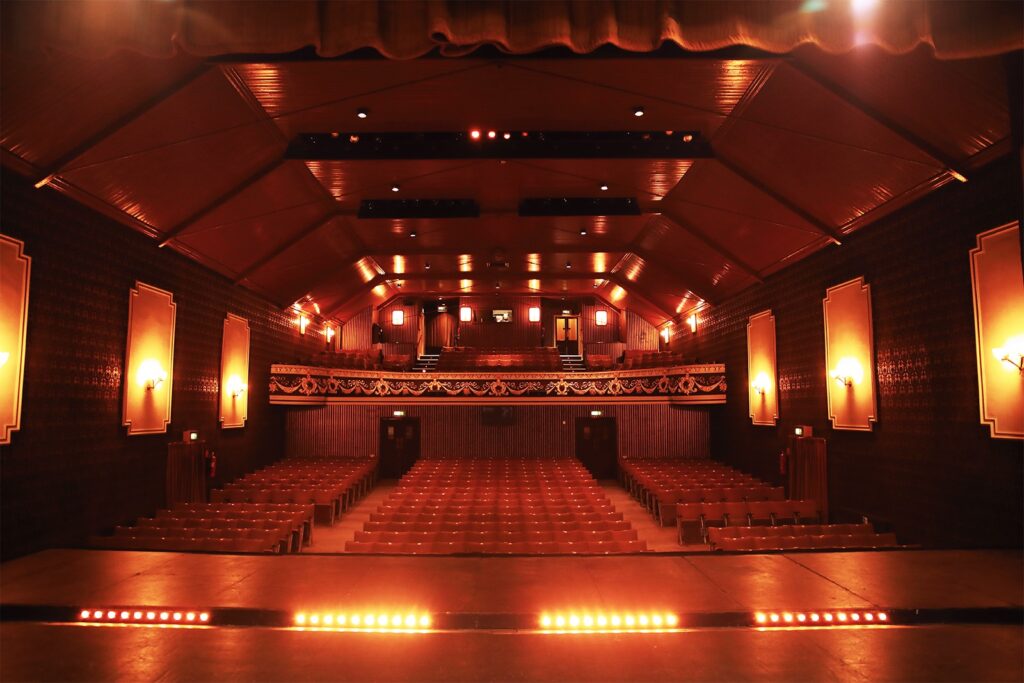Our guides, Keith and Frank welcomed 10 Friends’ members to the Theatre. We met in the Theatre bar, which used to be the bar of the Derby Arms pub adjoining the Theatre. Keith explained that the Hippodrome Theatre (built I 1914) had been a variety theatre and cinema before ending up as a bingo hall in the 1960s. Three local amateur operatic societies jointly bought the premises for £10 000 in 1978, gaining about £150 000 worth of dry rot. After nine years of hard graft, largely undertaken by volunteer members of the societies, Keith and Frank included, the Pendle Hippodrome Theatre opened in 1986. Since then, the societies have gradually merged to form the Pendle Hippodrome Theatre Company Ltd, a volunteer community charity.

The 19th century Derby Arms closed in 2014 and was bought by the Theatre Company with a view to enhancing its cramped facilities. Owing to lack of funds, the pub remained untouched – in areas almost derelict – until 2022 when the theatre received a grant from the government’s ‘Levelling Up Fund’. Since then, the Derby has been transformed. We began our tour on the ground floor where there is a bar, foyer, box office, toilets, offices and café. Climbing the magnificent, largely original staircase, illuminated by a beautiful stained-glass window, we arrived on the second floor which had four rooms for travelling salesmen, which are now being converted to store the company’s enormous collection of costumes. Going back down to the first floor we passed through the largest of a number of rehearsal rooms, where a band rehearsal was taking place.
Leaving the modernised part of the premises, we emerged at the back of theatre balcony. It was like stepping back in time, as we marvelled at our first view of the restored Edwardian theatre, which retains many of its original features, including the refurbished seats. Keith explained that cream/gold/brown colour scheme had been largely dictated by the shade of the fireproof paint that coated the original wooden ceiling. Many of the other fixtures and fittings had been ‘acquired’ from other local theatres that had closed. We took turns squeeze into the old projection room (that used to be much smaller!), which is now the theatre’s lighting control box. Nearby, seats had been removed to accommodate the digital sound control board and ice cream sales bar.
Photo: David Farrer

Moving downstairs we passed through the former foyer, box office, cloakroom and pay box area, wondering how cramped it must have been compared to the new premises we had seen earlier. We then tiptoed across the sloping floor of the former bar, where a play rehearsal was taking place. The floor slopes because the auditorium floor is ‘raked’ to enhance the view from the stalls. During the work to refurbish the theatre, it was impractical to install a level floor.

From here we entered a corridor that has recently been added to connect the ‘front of house’, i.e. the auditorium and bar areas, with backstage. Previously, anyone who needed to make that journey had to go outside the theatre! We now began the tour of areas not normally seen by the paying public. First was the maintenance workshop where much of the scenery and the props for shows are made, adapted or repaired.
. Moving up another set of stairs we entered the wardrobe department, housed in the former pub stables, that was acquired in the original purchase. Separated into gents’ and ladies’ outfits there are two rooms crammed with thousands of costumes: dresses, skirts, suits, trousers jackets, and a wonderful collection of period hats, not forgetting accessories such as ties, scarves, walking sticks and umbrellas. Pam, the recently retired Wardrobe Mistress, explained that the wardrobe team ‘dresses’ many plays, shows and school performances, as well as fancy-dress events from the amazing collection. This saves the company money on its own productions and also earns valuable income from external hire. It was upstairs – again! – to another Aladdin’s Cave – the props department, with a similar story to tell.


Having admired the expanded dressing rooms, we than found ourselves up in the 100-year-old grid, where a rope and pulley system enables scenery to be ‘flown’ i.e. lowered and raised to and from the stage. Not many grids of this type have survived to the present day. Much of this was refurbished in the 80s with equipment rescued from the Palace Theatre in Nelson. Keith drew our attention to the ‘original’ stage curtain 27 feet high and 40 feet wide, plus the Safety Curtain, with its century-old mechanism which, despite being a museum piece, is still in perfect working order.
Finally, after more stairs – down this time! – we arrived on the stage, which is also ‘raked’, where the stage crew were installing scenery for a forthcoming play. It was a real thrill when the curtain went up and we got a ‘cast eye view’ of the auditorium.
Photo: David Farrer
After tea and biscuits back in the bar area, our Chair, Dawn, thanked Keith, Frank and the other members of the theatre for making us feel so welcome. For members of the Friends who had never been backstage before, it was a real revelation to see the amount of work and the numbers of people who are involved in putting on a production. We were all very impressed with the obvious difference that the addition of the Derby premises had made and wished the Theatre Company every success in the future.
